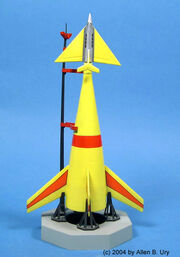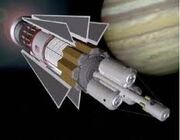In the 1950s rocket scientist Werner Von Braun set up a plan for exploring the Moon, Mars, and beyond. By now, we should have permanent bases on the Moon and Mars, with routine passenger travel to orbit. Other projects such as Project Orion also had ambitious goals. What if these projects had been accepted?
Inspiration[]
NASA is formed in 1955, after the Disney space travel series, along with Colliers magazine, inspires the world to the challenge of space travel. Movies like Destination Moon and Conquest of Space add to public enthusiasm. Seeing Project Orion as a means of achieving this prize, the merge the projects together.
First Satellites[]
In 1956, the first artificial satellite was launched. It is powered by reflected sunlight on a silicon battery. It also had a television camera used to image the earth. Orbiting at 1000 miles and circling the earth every two hours, the instrument would relay observations about the environment in space back down to a receiving station at the North Pole.

First Rocket/Spaceplane[]

XB-1, a ten-person spaceship, (shown above) was launched on September 17th, 1959. The ship is completely automated during launch. After extended testing of the first second and third stages the three stage rocket finally flew. It orbited at a height of 1075 miles above the Earth.
First Base in Space[]
After multiple flights of the XB-1 Spaceplane, a base was finally ready to be established. It was prefabricated on Earth, and launched aboard a gigantic Orion powered rocket before being reassembled in space. The 50 wheel operating at a height of 1075 miles is an outpost for earth observation, Space Research and Manufacturing, transmission of TV and radio broadcasts, as well as a base for building ships to travel beyond it. Established in 1963, it will orbit indefinitely.
First Passenger Travel to Orbit[]

Despite being extremely dangerous, the attraction of space travel was too great

for the public to miss out on. In 1963, Orion powered rockets were created that could take 1000s of people into space per flight. The ticket price was extremely high at over 50,000 USD per person (2001 dollars), but eventually dropped to $10,000 ,and later $5,000
Missions to the Moon and Mars[]
In 1965, a Orion Powered spacecraft launched on the first manned mission to the Moon. Within that same year, a base at Clauvius was established. That year, Pan Am began offering tourist flights to the moon as well as orbit. The base know at over 10,000 is the

largest outpost beyond the earth. In 1970 the First Manned Mission to Mars is launched. They are disappointed to find only microbes. However, it is discovered, like the moon, it has resources for colonization. A base is quickly created at is now over 1700 strong.

Venus and Failed plans[]
In 1975, a manned mission to explore Venus was launched. Test missiles fired in orbit show a hellish, volcanic landscape and quickly proved a landing is impossible. They stay for 30 more days before leaving. There are no plans on returning
Outer Planets[]
In 1989, the first in a long series of outer planet missions is launched. Even with the Orion drive ,they take several years. While Jupiter, Saturn, Uranus, and Neptune all prove to be lifeless themselves, their moons hold riches such as deep oceans or gigantic volcanoes. Bases were established on Titan, Europa, and

Interstellar Starship[]
With lifespans increasing, and the Orion drives becoming more and more mature, the idea of a starship was seen as the next logical step. A gigantic ship with over 200 crew members was launched in 2001. The ship will reach Proxima Centauri in 130 years
